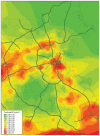Medium-term exposure to traffic-related air pollution and markers of inflammation and endothelial function
- PMID: 21349799
- PMCID: PMC3080929
- DOI: 10.1289/ehp.1002560
Medium-term exposure to traffic-related air pollution and markers of inflammation and endothelial function
Abstract
Background: Exposure to traffic-related air pollution (TRAP) contributes to increased cardiovascular risk. Land-use regression models can improve exposure assessment for TRAP.
Objectives: We examined the association between medium-term concentrations of black carbon (BC) estimated by land-use regression and levels of soluble intercellular adhesion molecule-1 (sICAM-1) and soluble vascular cell adhesion molecule-1 (sVCAM-1), both markers of inflammatory and endothelial response.
Methods: We studied 642 elderly men participating in the Veterans Administration (VA) Normative Aging Study with repeated measurements of sICAM-1 and sVCAM-1 during 1999-2008. Daily estimates of BC exposure at each geocoded participant address were derived using a validated spatiotemporal model and averaged to form 4-, 8-, and 12-week exposures. We used linear mixed models to estimate associations, controlling for confounders. We examined effect modification by statin use, obesity, and diabetes.
Results: We found statistically significant positive associations between BC and sICAM-1 for averages of 4, 8, and 12 weeks. An interquartile-range increase in 8-week BC exposure (0.30 μg/m3) was associated with a 1.58% increase in sICAM-1 (95% confidence interval, 0.18-3.00%). Overall associations between sVCAM-1 and BC exposures were suggestive but not statistically significant. We found a significant interaction with diabetes-where diabetics were more susceptible to the effect of BC-for both sICAM-1 and sVCAM-1. We also observed an interaction with statin use, which was statistically significant for sVCAM-1 and suggestive for sICAM-1. We found no evidence of an interaction with obesity.
Conclusion: Our results suggest that medium-term exposure to TRAP may induce an increased inflammatory/endothelial response, especially among diabetics and those not using statins.
Figures



References
-
- Albert MA, Danielson E, Rifai N, Ridker PM. Effect of statin therapy on C-reactive protein levels: the pravastatin inflammation/CRP evaluation (PRINCE): a randomized trial and cohort study. JAMA. 2001;286((1)):64–70. - PubMed
-
- Albert MA, Ridker PM. The role of C-reactive protein in cardiovascular disease risk. Curr Cardiol Rep. 1999;1((2)):99–104. - PubMed
-
- Bell B, Rose C, Damon A. The Normative Aging Study: an interdisciplinary and longitudinal study of health and aging. Aging Hum Dev. 1972;3:4–17.
-
- Blanco-Colio LM, Martin-Ventura JL, de Teresa E, Farsang C, Gaw A, Gensini G, et al. Elevated ICAM-1 and MCP-1 plasma levels in subjects at high cardiovascular risk are diminished by atorvastatin treatment. Atorvastatin on Inflammatory Markers study: a substudy of Achieve Cholesterol Targets Fast with Atorvastatin Stratified Titration. Am Heart J. 2007;153((5)):881–888. - PubMed
-
- Brauer M, Hoek G, van Vliet P, Meliefste K, Fischer P, Gehring U, et al. Estimating long-term average particulate air pollution concentrations: application of traffic indicators and geographic information systems. Epidemiology. 2003;14((2)):228–239. - PubMed
Publication types
MeSH terms
Substances
Grants and funding
LinkOut - more resources
Full Text Sources

